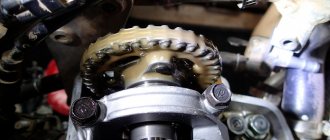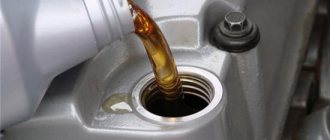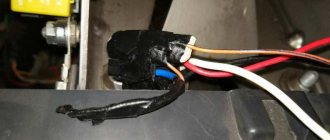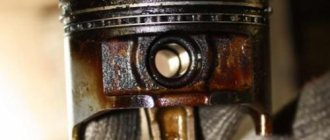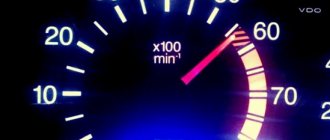Signs and causes of an engine jam in a car
Contrary to the common misconception that a low-mileage engine in a new car cannot seize, alas, it is worth saying that a similar problem can happen to any engine and at almost any mileage. Engine “wedge” is a problem for which any motorist must be mentally and financially prepared.
Sometimes this happens suddenly, but sometimes the engine gives warning signals to the driver long before failure, and one of the main reasons for immediate failure in this case may be scuffing, deformation, destruction and soldering of parts.
How is it happening?
Most often, foreign objects enter through the carburetor flaps. Dust and larger inclusions also get there when cracks form along the air intake path. It is necessary to check the integrity of the pipes and the cleanliness of the filter.
After repairing the carburetor, a loose spare part could fall into the engine well. Similar consequences can result from careless installation of the engine head with valves. It would be a good idea to check the cleanliness of the lubricant by draining it from the crankcase. But the latest work is carried out on the pit under service conditions.
What is a motor wedge?
Let's start with the fact that if the engine is operating in its nominal mode, that is, normally, then all moving and rubbing elements of this engine that interact with each other must be lubricated with lubricants that are appropriate and specific to the technical characteristics of the engine. For example, it is unacceptable for the piston ring to be in direct contact with the cylinder walls - between the elements there must be a thin layer of oil film, which reduces friction and, accordingly, can extend the trouble-free operation of the engine, not limited to several thousand kilometers, but several hundred thousand.
However, if this thin micron-thick layer of lubricant disappears from the honed surface of the cylinder and the metal elements come into contact with each other without lubrication, even microscopic irregularities will cause a rapid increase in friction, as a result of which most of the mechanical energy (up to 95%) is converted into heat . And the most dangerous thing for internal combustion engines will begin - dry friction.
The problem is that once such a process begins, over time (and quite quickly) it will only worsen, one problem will lead to another. The more the rubbing elements heat up, the more they will expand, increasing pressure and displacing the remaining oil film.
Even if the lack of lubrication was a temporary phenomenon, as the metal expands due to its heating, the gaps will decrease and the engine oil may simply cease to perform its function of reducing friction between the involved components, simply being forced out of critical places.
In extreme cases, so much heat can be generated that the engine will eventually stop abruptly, signaling a costly repair (at best) or the need to purchase a new motor.
Often, when the engine is starved of oil, the connecting rod bushings jam.
In this case, the bushing can rotate, and the pin can get jammed both in the upper head of the connecting rod and in the piston bosses, which can lead to the “hand of friendship”; the cylinder block can be pierced by the connecting rod without hope of subsequent restoration. see also
Ten signs that your car is seriously faulty
In other cases, the working parts simply actively “rub”, wearing out the mating surfaces at an accelerated pace or deforming them. Such a crippled engine may start after cooling, but it is unlikely to operate at its nominal value. It will knock, rattle and pull poorly, for example due to worn bushings, or smoke like hell due to worn rings.
We would like to tell you about the 10 most common causes of engine seizure. Perhaps, knowing them, you will be able to avoid expensive repairs or at least reduce their cost by noticing the problem in time.
Additional sources of failure
If after basic checks it remains unclear why the engine jammed, it is recommended to recall previous events. Have you added oil before, and if so, what quality? Two oils of different types and viscosities could easily curdle and foam.
Adding low-quality additives to engine oil will also adversely affect the operation of its components. Similar consequences will occur when using oils not recommended by the manufacturer.
Fuel affects the condition of the pistons and rings. Too high an octane number leads to their deformation, and because of this, many people have had their engines seize up more than once. The cause of the malfunction may also be a malfunction of the ignition system.
Ridiculous cases
If the engine seizes, signs of thickened oil may indicate sugar entering the system. Similar consequences occur when stirring a raw egg, which, when the motor is running, will certainly heat up and weld all the channels. How the latter substance enters the system is known only to the owner of the car.
Sugar can be poured into the fuel by ill-wishers through the refueling hatch. There are many substances that change the composition of the oil. It happens that a driver may mistakenly pour a mixture that is lethal to iron into the engine neck.
A malfunction where coolant penetrates into the oil can also lead to jamming of the rubbing metals. This can be noticed when measuring the level using the dipstick. The changed composition is noticeable to the eye and to the touch: by color, viscosity, and the presence of foam. A whitish tint indicates a loss of oil quality.
Lack of engine oil
photo: freebie.photography
Every engine burns at least a small amount of oil, so if the driver does not check the oil level for a long time, the engine is at risk of seizing.
In the case of new engines that have not yet been run-in, or, conversely, in heavily worn old engines, oil consumption can even exceed 1 liter per 1000 km.
If the oil level approaches the minimum, the likelihood of failure increases. Just because there is sufficient oil pressure in the pan during normal driving with a minimum amount of oil in the pan does not mean that it will also remain so, for example, when driving fast on the highway or during long, tight turns, when centrifugal force pushes most of the oil into the pan, where the oil pump can no longer reach it.
What to do with a jammed car engine?
You get into the car, insert the ignition key, but the engine does not want to turn on or turns on in a very suspicious way. What to do with a jammed car engine?
If the engine does not want to start, you need to stop and think about what the reason might be. Experienced drivers do not have the question of what to do with a jammed car engine?
They know that for normal engine operation two main conditions must be met. Firstly, access to the fuel-air mixture must be ensured into the cylinders, and secondly, there must be a spark at the spark plug.
Therefore, first of all, check the supply of the fuel-air mixture
Experienced drivers immediately pay attention to the oil level. The instrument panel is equipped with a pressure light to monitor the oil level in the oil pump.
The light flashes when the oil level is low. The oil level can drop for various reasons: the oil receiver, the oil pump or its drive are broken, the mesh at the pump inlet is clogged. In general, you should watch it. It may even happen that even with good oil pressure, the car’s engine seizes for a slightly different reason - some channel in the engine itself is clogged due to poor quality oil.
The engine may not want to start due to loss of coolant. The car flies along the road, pouring antifreeze on it. The engine overheats greatly, parts suffer - cylinder mirrors, rings, pistons. If the Tosol coolant no longer flows onto the road, but into the crankcase, then the pump pumps not the oil, but its mixture with the coolant. Such “lubrication” spoils the bearings, on which the good operation of the crankshaft depends, and the camshaft may also suffer.
It also happens that part of the damper breaks off from the timing chain and falls not into the oil pan, but between the chain and the crankshaft sprocket. It’s easy to get rid of such a “wedge” - engage a higher gear and roll the car back a little. The dampener itself will easily fall into the pan.
If everything is fine with the oil, check the ignition. Unscrew the spark plugs and look into the cylinder. When carrying out this operation, use well-insulated pliers and wrap their ends with rags so as not to damage the wires. The procedure for checking for the presence of a spark is as follows: insert the unscrewed spark plugs into the tips and apply them one by one to the ground while the engine is idling. If there is no spark, fix the problem. If, even after returning the ignition system to normal operation, the engine still does not start as it should, check the starter.
It may well happen that the starter gear is jammed in the drive disk, in its ring gear. You need to try to turn the engine clockwise using the crankshaft pulley.
The starter relay may also fail. If after this the jammed engine does not start, remove the pump wire belts and the so-called genes.
Next in line is to drive the car into the pit, remove the cover from the clutch housing, make sure that everything is fine in the basket and try to turn it by the flywheel with a pry bar. Pull out the distributor drive and apply the so-called curve in common usage among car enthusiasts. Pour oil into the cylinders and try to turn them again with the spark plugs removed.
Now let’s take a look at the other possible causes of the engine “wedge” one by one. Check the battery for rust, oxidation, or loose wire ends attached to it. Check the battery to see if it is charged - dead or not. This is done as follows: put the ignition key in the ON position and turn on the wipers or headlights, which should work if the battery is working.
It may be necessary to clarify the position of the transmission in the “P” position. By the way, the funniest reason for the engine stopping may be the lack of fuel in the tank. Or water got into the gasoline. Make sure that the wiring in the starting system works - check the condition of the wires, connections on the battery, and the ignition switch.
Wrong choice of engine oil
photo: en.wikipedia.org
Using an unsuitable lubricant, which results in a weak oil film and/or increases the rotation speed, causing the oil film to simply scatter to the sides without settling on the hone.
Warning! Modern liquid oils with low resistance (low viscosity) are more susceptible to this phenomenon than “non-ecological” thick oils with parameters such as 10W60.
Causes
Quite often, wear and tear causes the bearings to turn. In this case, the oil wedge becomes increasingly worse due to too large a gap between the liners and journals. The process resembles a chain reaction, and not only the lubrication regime deteriorates. Simply put, the oil layer ceases to dampen the loads transmitted to the journals, especially sharp ones at the moment of ignition of the fuel mixture in the cylinders. As a result, these loads become shock loads, which further contributes to the squeezing of oil out of the gap, contact of the journals with the liners, and, naturally, wear of the latter. The reasons for rotation of the bearings can also be other factors that lead to disruption of the normal lubrication regime: inappropriate oil, deterioration in the performance of the oil pump, etc. In addition, loads on the journals can become shock-like when the engine is running hard: for example, due to incorrect setting of the ignition timing in gasoline engines, or the injection angle in diesel engines. By the way, excessively temperamental driving also does not increase the service life of the liners (see photo).
Oil dilution with fuel
photo: carkeys.co.uk
This is a common problem with diesel engines equipped with particulate filters.
During the so-called forced regeneration of the diesel particulate filter (DPF), that is, the afterburning of soot by increasing the temperature in the filter, the injection system supplies additional doses of fuel to the engine. There can be so much of it that the unburned excess flows down the surfaces of the cylinder walls and penetrates into the oil. If the process goes correctly, there are no problems - the fuel evaporates under the influence of temperature and flows back into the combustion chambers through the crankcase ventilation.
It’s worse if, for example, the car drives very short distances or the engine stalls while burning soot - then the unburned fuel is concentrated in the oil, and over time it becomes so much that it will no longer evaporate, and the liquefaction process will begin with a subsequent deterioration in the quality of fuel and lubricants.
Due to the ingress of diesel fuel, the oil level may even rise above the maximum risk - there may be so much fuel in the crankcase.
Typically, components that are particularly sensitive to poor lubrication will begin to suffer first, such as turbocharger bearings or timing drive components.
The problem is difficult to detect, since on many cars the increase in oil level due to the admixture of fuel is compensated by the natural combustion of engine oil - the oil level remains practically unchanged, although its composition will obviously be different.
Irregularities at work
If the engine is jammed, also check the moment of spark formation in the engine. Each moment of fuel ignition must occur when it is at its highest point. If this is delayed, there will be resistance to the movement of the crankshaft when the other piston is pushed down with force due to the mixture.
Similar problems arise when fuel is not injected into the piston in a timely manner when the spark is supplied correctly. It is better to diagnose these components in a car service center using modern equipment. It is also not allowed to drive in hot weather with a faulty radiator cooling fan.
The oil pump is mechanically connected to the crankshaft. The sufficiency of oil reaching the rubbing surfaces is checked. Unfortunately, it is possible to diagnose hidden defects when the engine has already seized. VAZ has similar problems with insufficient car care.
Oil starvation inside the engine occurs when the level in the crankcase is constantly low. The crankshaft should practically be bathed in protective additives. Otherwise, the metal expands under the influence of temperature. Therefore, delaying periodic oil changes is strictly not recommended.
Engine oil in coolant
photo: drive2
There may be several reasons for this, including damage to the cylinder head or cylinder head gasket, corrosion of liners, and so on, including failure of the heat exchanger gasket.
If the oil mixes with the coolant, a mayonnaise-like emulsion will form, or if the coolant gets into the oil, whitish foreign flakes will be visible in it. The lubricating parameters of such a mixture are much worse than those of pure oil, and it can also clog oil channels.
In addition, the likelihood of such a unit jamming increases due to the fact that the more coolant is drained from the engine, the worse its cooling will be.
Warning! The problem of coolant in the oil affects not only engines, but also automatic transmissions. “Automatic machines” are often equipped with oil coolers connected to engine cooling. If the seals fail, antifreeze can leak into the transmission oil.
Meanwhile, minimal contamination of the transmission oil is enough for the gearbox to become unusable and simply break. The first sign of an impending problem is usually the transmission slipping, which can result in complete loss of drive.
Antifreeze reacts with friction lining materials. The linings peel off and get into the gearbox oil system, blocking the channels and accelerating wear of the elements.
If the gearbox is not working properly, before repairing it is worth contacting a mechanic with a request to inspect for the presence of coolant in the transmission oil; special reagents are used to identify it.
Belt break
A disastrous result is observed when the timing belt or chain breaks. Often the cylinder blocks even bend. At the moment of impact, the valve covers break. As a result, the engine has to be overhauled.
If repairs are insufficient, broken parts may remain in the crankcase; under some circumstances, they will again end up in the next engine wedge. A loose damper can also get caught under the timing belt or chain. Valves and cylinder blocks become deformed under incorrect operating conditions.
Scores appear that constantly touch the moving metal. At some point, when the wear becomes large enough, final wedging occurs and the crankshaft can no longer be turned.
Clogged/coked oil channels
photo: carmagazine.co.uk
The most common causes of this problem are the use of poor quality motor oils and excessive drain intervals, or both.
It's also worth knowing that using name brand oils will not always prevent problems. Firstly, some are not as good as they are portrayed in advertising (ask auto mechanics), and secondly, there are many fakes on the market.
Not only the brand of oil is important, but also its origin.
Often the mechanics themselves are also to blame for the breakdown because they were careless. It happens that, for example, after replacing a seized turbocharger or head gasket, they forget to flush the lubrication system of metal filings and other debris such as overheated engine oil. Sometimes the oil line becomes blocked, for example due to excessive use of silicone when sealing the cylinder head cover or oil pan.
Where does knocking come from when the engine is hot?
The reasons can be very different, and the first priority when detecting knocking noises is to understand what parts are causing it. The service life of the engine as a whole depends on finding the cause in a timely manner and quickly solving problems.
- The most harmless reason lies not in the mechanism, but in a decrease in the engine oil level. When the engine knocks when hot, in road conditions the most that can be done is to use a dipstick to find out the current engine oil level. Lack of lubrication provokes friction of adjacent parts against each other, they can be damaged, which causes the appearance of characteristic knocking sounds.
When adding oil to the required level, the knocking should stop.
It is necessary to listen to the intensity of the knocking noises; if there is a clear increase in them, then it is better to contact a car service center and conduct engine diagnostics. If the knocking in the engine when hot is uniform and is characterized by subsidence with increasing temperature, and no visible malfunctions or problems are detected, the car can be operated for tens of thousands of kilometers before it needs to be repaired. The knocking noise may come from the crankshaft. If the engine is under load, and the knocking occurs with increasing force, progressing over time, then the search for the problem is narrowed to the crankshaft bearings. It is dangerous to continue driving with such a malfunction, otherwise the situation will worsen and the engine will need to be overhauled. A knock in a hot engine can be produced by the valves when the crankshaft speed increases and the pressure in the lubrication level system decreases at the same time. In order to get rid of the knocking, you first need to normalize the pressure in the system so that the engine functions normally.
It is important to select only a motor oil whose viscosity and properties satisfy the climatic conditions of a particular region, taking into account the season.
If the oil pressure is normal and the knocking does not stop, then you will have to remove the valve covers and check the clearances. Increasing clearances is the main reason for knocking and subsequent wear of parts.
This phenomenon is typical for cars with significant mileage, where gaps appear due to long use and natural wear of parts. The gaps must be set correctly; they are adjusted using a special set of feeler gauges that are placed in the spaces between the rocker arm and the top of the valve.
- As engine temperature changes, knocking noises can either increase or decrease. The first case is due to the fact that worn parts may expand slightly when warmed up, thereby reducing the gap, and this in turn leads to the natural disappearance of the knock. This situation is often observed in the cylinder-piston group of the engine. The second case is related to the heating of the engine oil. As you know, when the engine is hot, it liquefies, which can increase knocking in the bearings of the crank mechanism. Continuing to drive a car while the engine is knocking is very dangerous. To avoid serious damage to the engine unit, it is better to call a tow truck and take the car to a service station, where specialists will identify the exact cause and immediately eliminate it.
- Sometimes knocking occurs due to the human factor. A simple example: forcing a puddle at high speed leads to water hammer, which can lead to bending of the connecting rod. It happens that the part replaced during repair had a broken geometry, was of poor quality, or was installed incorrectly. The load on such parts increases significantly, which inevitably leads to deterioration of lubrication and an increase in temperature in the area of their operation. The result is rapid wear, increased gaps, and subsequently knocking.
If, after checking the gaps of the connected parts, it turns out that they correspond to the standard, it can be assumed that the engine is knocking when hot due to intense loads, or due to long-term operation in an overheated state. As a result, strong friction of parts quickly destroys the lubricant.
Oil pump malfunction
photo: procarmechanics.com
In this regard, Volkswagen's two-liter TDI engines have gained notoriety in recent years. These engines used two extremely inefficient and low-quality versions of oil pumps - in one the pump chain drive constantly failed, in the other there was a very thin shaft driving the pump, which also often fails.
see also
The best gasoline engines of recent years (19 models)
The effect in both cases is the same - the oil pressure drops without any warning, and now seconds separate a normally operating engine from failure and seizure of an engine operating at high speeds.
When the engine jams, what flies?
This is the situation. Starlet's car is '98, the girl drove around the city (apparently with a minimum of oil), I went out of town on a holiday. and her engine seizes on the highway. While there is no way to take it to a service center, I wanted to know what would happen in this case. fails. for replacement. It turns out that this is the capital of the engine that needs to be done. Samo used to have a starlet, so I’m rooting for her..
I forgot to say the most important thing, the engine is 4E-FE 1.3.
On 4th 5th the valves don’t seem to bend - because there are recesses in the pistons for them (recesses) - if the timing belt breaks, otherwise = bad, you need to look. but you DEFINITELY got into the capital! Your crankshaft bearings most likely turned, the belt snapped, as long as the connecting rods and the piston didn’t hit.
The car must be NEW, or TOYOTA!
[email protected] — RULEZZZ FOREVA .

